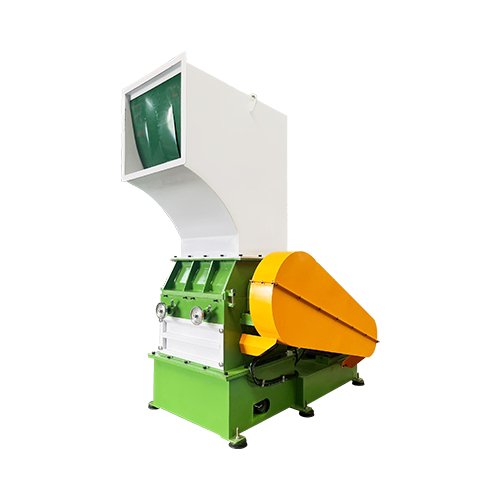カーボンピーキングとカーボンニュートラル、そして循環型経済という2つの目標に後押しされ、プラスチックリサイクル業界はかつてない発展のチャンスに直面している。プラスチック・リサイクル生産ラインの最初の重要なステップであるプラスチック粉砕機の性能と効率は、その後の選別、洗浄、ペレット化工程の品質とコストを直接左右する。近年、人工知能、モノのインターネット、省エネ伝送などの新技術がより多く使用されている。このため、プラスチックシュレッダーは急速に変化している。古い機械的な設計から脱却しつつあるのだ。その代わりに、よりスマートで、よりオールインワンで、より環境に優しいものになりつつある。この記事では、プラスチックシュレッダーの技術的進化、革新的なアプリケーション、将来のトレンドについて掘り下げ、このインテリジェントな変革の背後にある秘密と価値を明らかにする。
I.技術の進化:伝統的メカニクスからインテリジェント制御へ
プラスチック破砕機の開発は、環境保護の要求と絡み合った技術革新の歴史である。20世紀初頭、発明家たちはすでにプラスチック破砕機を生み出していた。当初、人々は主にボトルやバッグのような単純なプラスチック製品の処理に使用していた。しかし、その後、プラスチック製品はどこでも使用されるようになり、プラスチック廃棄物の量が大幅に増加した。このため、古いシュレッダーでは、迅速かつ正確なリサイクルのニーズに追いつけなくなった。
1.従来のプラスチック破砕機の原理
プラスチックを破砕する初期の機械は、平らな刃で材料を切断し、衝撃で破砕する方法を採用していた。強力なモーターで高速回転するローラーで構成され、プラスチック製品を細かく切断した。この機械はシンプルな構造で、製造コストも安かった。また、エネルギー消費量が多い、運転音がうるさい、刃の侵食が早い、切断されたプラスチック粒子の大きさが不揃いである、といった大きな欠点もあった。高効率、高精度、低エネルギー消費の近代的なプラスチック・リサイクル産業の要求では、古い装置はその要求を満たすことができない。
2.従来の機械式機器からインテリジェント機器への進化
21世紀以降、材料科学、制御技術、センサー技術の進歩により、プラスチック破砕機は "機械的駆動 "から "インテリジェント制御 "へと徐々に移行している。 モダン・インダストリアルsチッククラッシャー シュレッダーにはさまざまなタイプがあり、一般的にモジュール方式で設計され、高効率で省エネのモーター、インテリジェント制御システム、自動潤滑装置、遠隔診断モジュールなどが装備されています。これらの改良により、シュレッダー装置はより高速で安定した運転が可能になり、同時にメンテナンスコストとエネルギー消費量を削減することができます。
3.プラスチック破砕におけるAIとIoT技術の応用展望
現在、人工知能(AI)とモノのインターネット(IoT)技術は、プラスチック破砕装置への統合を加速させている。例えば、画像認識やディープラーニング・アルゴリズムによって、投入されたプラスチックの種類を自動的に識別し、それに応じて破砕パラメーターを調整することができる。一方、センサーは温度、振動、電流など装置の稼働状況をリアルタイムで監視し、故障警告や予知保全を可能にする。これらの技術を使うことで、装置はよりスマートになる。また、プラスチック・リサイクル業界がデジタル方式に移行する際にも強力な助けとなる。
II.プラスチック粉砕機の革新的設計と最適化
物事をよりスマートにするというトレンドの中で、プラスチックシュレッダーを設計する人々は、単に粉砕を良くするだけではない。彼らはまた、高効率であること、より少ないエネルギーを使用すること、環境に良いことも同様に重要な目標であると考えています。このため、専門のプラスチック破砕機メーカーは、構造、材料、伝動システムなどの多次元において綿密な調査と最適化を行う必要がある。
1.高効率・省エネプラスチックシュレッダー設計の核心

デュアルカーボン "の背景の下で、省エネと排出削減はプラスチック破砕機の設計における主要な課題として位置づけられている。高効率で省エネのプラスチック破砕機の設計理念を取り巻く実際の核心は、「精密破砕」と「エネルギー利用の最大化」と表現される。従来の破砕ルーチンは、エネルギーの無駄な消費とエネルギー損失の高さにつながる。一方、現代的な設計は、細断室内での材料の不必要なタンブリングや摩擦を減らすために、細断室内での材料のより均一で効率的な力分布が達成されるように、細断室の幾何学的構造の最適化に焦点を当てている。例えば、新しい設計のいくつかは「W」や「V」形状のブレードであり、遠心力が関与するため、より良い切断角度を持つ。
2.省エネモーターと高効率送電システムの応用
可変周波数ドライブ(VFD)技術は、省エネモーターや高効率トランスミッションシステムの標準となっている。VFDでは、モーターの回転数を実際の負荷に基づいて無段階に調整することができる。これにより、従来のモーターが部分負荷で作動する際の低効率の問題を効果的に回避することができる。
IE3またはIE4定格の高効率モーターも使用される。従来のベルトドライブに代わって、ダイレクトドライブまたは高精度ギアトランスミッションシステムが採用されている。このような変更により、伝達時のロスを減らすことでエネルギー節約を最大化します。
多くの専門のプラスチックシュレッダーメーカーは、大規模な産業用プラスチック破砕機で永久磁石同期モータの使用を模索している。これにより、電気エネルギー変換効率がさらに向上します。
III.インテリジェント制御システム:オートメーションからインテリジェンスへ
1.プラスチック粉砕機における自動化制御技術の利用
現在、ほとんどのプラスチックシュレッダーにはPLC制御システムが導入され、装置の起動と停止、速度調整、故障警報などの自動運転の実現が可能になった。より先進的なシステムは、タッチスクリーンを追加し、本当にリモートでマンマシンインタフェースを追加し、データをより完全にし、機器の操作とメンテナンスを容易にします。
2.インテリジェント監視・故障警報システムの実装方法
現在、ほとんどのプラスチックシュレッダーは、装置のスタートアップとシャットダウン、速度調整、故障アラームを含む自動運転を実行できるPLC制御システムが設置されている。より高度なシステムはタッチスクリーンを備え、マンマシンインターフェースを追加し、遠隔操作でデータをより完全なものにし、機器の操作とメンテナンスをより容易にする。

機器の稼働状況をリアルタイムで監視するため、通常は温度、振動、電流などのセンサーが要所に設置される。これらのセンサーが収集したデータは、エッジコンピューティングを使用して前処理された後、クラウドプラットフォームに送信される。観測されたパラメータのいずれかが設定されたしきい値を超えたことをシステムが検出するたびに、ベアリングの温度が設定されたしきい値を超えるなどの条件では、システムは自動的にアラームを発生させ、機器を停止させ、機器の損傷を防ぎ、安全事故を防止する。
3.インテリジェント制御システムの利点と課題
インテリジェント制御システムは、機器の運転効率を大幅に改善し、人件費を削減し、機器の寿命を延ばすことができる。しかし、このようなシステムには、データ・セキュリティの問題、システム間の互換性の問題、オペレーターに対するより高い技術要件などの課題もある。将来的には、業界標準を洗練させる必要がある。また、技術トレーニングを強化する必要もある。インテリジェント・コントロール・システムの普及を促進すべきである。これらのシステムは、より良くなっていくはずだ。
IV.プラスチック破砕機持続可能な発展を支える
プラスチック廃棄物を事前に処理することなく直接リサイクル工程に投入すると、その量が多いために輸送・保管コストが高騰し、その後の洗浄・選別・ペレット化が困難になる。シュレッダー工程は、大きなプラスチック製品(廃棄された水筒、包装フィルム、車のバンパーなど)を効率的に粉砕し、均一な大きさの破片や粒子にすることができる。これらの細断された材料は、それらが占めるスペースを減らす。そのため、まとめて処理することが容易になる。また、標準化された原材料となる。これらの原料は、洗浄、乾燥、溶解、ペレットの製造といった次のステップに進む準備が整っている。これにより、高品質の再生プラスチック製品を生み出すための舞台が整うのである。

プラスチック破砕機は、プラスチックのリサイクルと再利用を可能にし、埋め立て地への負担と焼却による環境への影響を大幅に軽減します。世界中で、毎年何十億トンものプラスチック廃棄物が発生しています。この廃棄物のほとんどは埋立地に運ばれています。埋立地は貴重な土地を使います。また、有害物質を放出して土壌や地下水を汚染する。その他のプラスチック廃棄物は燃やされる。燃やすとダイオキシンなどの有毒ガスや温室効果ガスが発生する。再生プラスチック産業は、産業用プラスチック破砕機によって支えられている。この破砕機は、廃棄されていたこれらの資源を再び生産サイクルに戻し、埋め立て地や焼却炉に入るプラスチックの量を直接的に削減する。
再生資源の有効活用と経済的価値の向上は、持続可能な発展に対するプラスチックシュレッダーの重要な貢献である。シュレッダーとリサイクルによって、かつては無価値であった、あるいは有償廃棄が必要であったプラスチック廃棄物に、新たな命と商品価値が与えられる。例えば、人々は古いペットボトルを細断することができる。そしてそれを洗浄し、加工する。その結果、再生繊維ができる。この繊維は衣服やカーペットに使われる。また、廃棄されたPEやPPのプラスチックもリサイクルできる。それらはゴミ箱やパイプ、パレットなどになる。これは企業に新たな金儲けの方法をもたらす。また、大きな産業の創出にも役立っている。この産業には、リサイクル、選別、破砕、新製品の製造が含まれる。これは多くの雇用を創出する。また、グリーンな循環型経済モデルも形成する。このような観点から、プラスチック破砕機は環境ツールであるだけでなく、グリーン経済の強力な推進力でもある。
V.革新的なアプリケーション・シナリオの拡大:単一シュレッダーからシステム統合へ
1.医療廃棄物処理におけるプラスチック破砕機の応用
使用済みの点滴セット、注射器、血液バッグなどの医療用プラスチック廃棄物は、人体や体液に直接触れるため感染リスクが高く、素材によっては腐食性もある。そのため、このような廃棄物の処理には、通常のプラスチックよりもはるかに厳しい要件が課せられ、処理中に二次汚染を引き起こさないようにするとともに、病原菌の拡散を効果的に防止することが求められる。専門の医療用ボトル破砕機は、物事の安全性を維持し、環境を保護するために多くの高度な技術を使用しています。これらのシュレッダーは非常にタイトなシールを持っています。このデザインは、細断中にほこり、エアロゾル、または破片が外に出るのを阻止します。それはまた、可能性のある生物学的危険を遠ざけるのに役立ちます。窒素保護システムを導入することで、シュレッダー室内に酸素のない環境を作り出し、特定の材料の酸化や燃焼を防ぐだけでなく、微生物の活動を抑制し、感染のリスクを低減します。プラスチック破砕機は、医療業界でどのように革新的に応用されているのでしょうか?
2.電子廃棄物リサイクルのためのプラスチック破砕ソリューション
電子廃棄物には大量のプラスチックと金属が混在しており、従来の破砕方法では分離効率が悪い。新世代のプラスチック破砕機は、金属検出、磁気分離、空気分離の機能を統合し、プラスチックと金属の効率的な分離とリサイクルを実現する。コア技術は、高感度金属検出システムを破砕プロセスに組み込み、金属不純物をリアルタイムで識別し、選別メカニズムを起動させる。その後、強力な磁気分離装置が効率的に鉄系金属を吸着し、インテリジェントな空気分離モジュールが材料の密度差に基づいて非鉄金属(銅やアルミニウムなど)とプラスチック片を正確に選別する。
3.自動車プラスチック部品のリサイクルのためのシステム統合ソリューション
自動車用プラスチック部品は種類が多様で構造が複雑なため、リサイクルが難しい。古い自動車部品は大量に捨てられている。これらの部品にはバンパーやダッシュボードなどが含まれる。これらは混合プラスチックでできており、複雑な形状をしている。そのため、従来のシュレッダーではうまく処理できない。現在では、プラスチック破砕機を製造する会社が手助けをしてくれる。彼らは特別なシュレッダーを提供しています。これらのシュレッダーはゆっくりと回転するが、強力なパワーを持っています。時には、これらの企業はまた、早期処理のために余分なシュレッダーを追加します。これらの特別なシュレッダーは、丈夫で大きなプラスチック廃棄物を扱うことができる。彼らは効率的に廃棄物を細断する。これは、後に材料をリサイクルすることが可能になります。
Ⅵ.プラスチックシュレッダーの将来展望
今後、プラスチックシュレッダーは、環境の持続可能性と効率性を高める方向に進化していくだろう。
1.環境の持続可能性の観点から
低炭素製造技術が推進される。水素エネルギーを動力源とする実験モデルはEUのCE認証を取得し、従来の装置と比較して92%の二酸化炭素排出量を削減し、2025年までに商業化が見込まれている。
2.効率性の観点から
装置の処理能力と効率は改善され続けるだろう。刃の設計を最適化し、モーターの効率を向上させ、制御システムを強化するなどの対策を通じて、破砕比や容積効率などのプラスチックシュレッダーの主要性能パラメータは、新たな高みに達するだろう。
として プラスチック粉砕機の専門メーカー私たちは、技術革新と製品の最適化に尽力し、お客様により効率的で、インテリジェントで、環境に優しいプラスチック破砕ソリューションを提供します。まもなく、プラスチック破砕機は世界のプラスチックリサイクル業界においてますます重要な役割を果たすようになり、持続可能な開発と美しい地球を構築するためのより大きな努力に貢献すると信じています。
Ⅶ.結論
プラスチックシュレッダーは、単純な機械的装置から人工知能やIoT技術を統合できる複雑な装置へと進化し、技術的な進歩やアプリケーションの革新が著しい。今日、人々はプラスチックを小さくするためだけにこれらの機械を使用しているわけではない。これらの機械は今や循環経済システムの重要な一部となっている。世界的なプラスチック問題の解決に役立っている。また、グリーン開発のアイデアの実践にも役立っている。
プラスチック破砕機は、インテリジェンス、効率性、専門性のレベルを継続的に向上させることで、プラスチックリサイクル産業の発展と変革を牽引し続けるだろう。その実用化は、技術が利便性をもたらすだけでなく、環境問題の解決にも役立ち、前向きな変化をもたらすことを示している。
